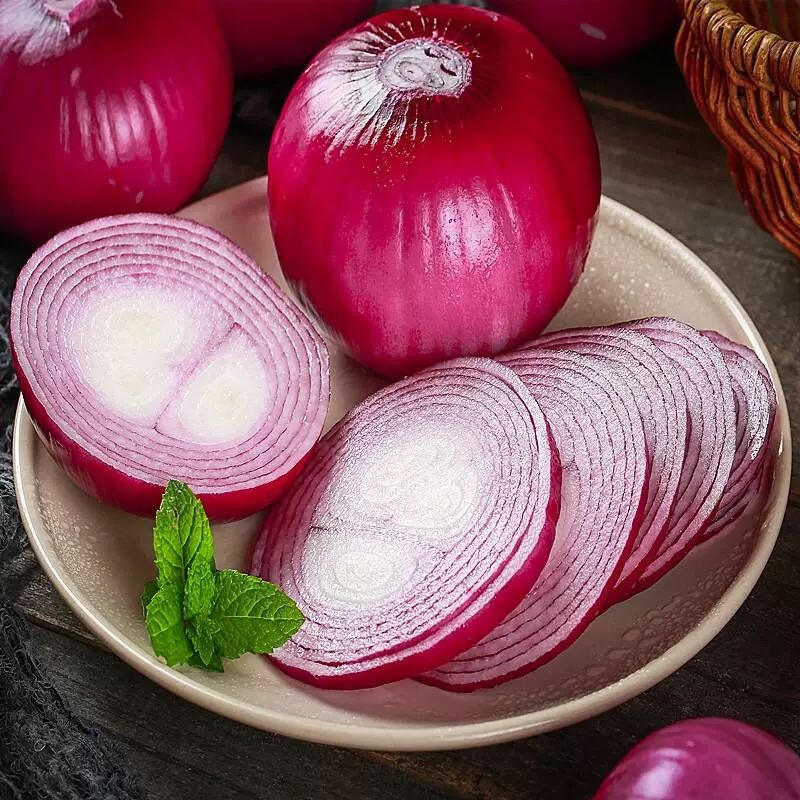The
onion is a biennial herb belonging to the genus Allium in the family Alliaceae. Its roots are fibrous. The stem, shortened into a disc, is flattened and conical. The leaves are cylindrical and hollow, with the widest part at the base and gradually tapering upwards, shorter than the flower stalk, and over 0.5 cm in diameter. The leaf sheaths are thick and scale-like, densely covering the shortened stem, forming the bulb. The onion comes in various colors, including purple-red, pink, copper-yellow, light yellow, or white. The flowering and fruiting period is from May to July. As early as the third century AD, after the opening of the Silk Road during the Western Han Dynasty, it was gradually introduced to China. Because it was an exotic plant, it was called 'onion.'
Originally from western Asia, onions are cultivated throughout China and are available year-round. Cultivation of onions dates back to ancient Egypt, and they were later introduced to various regions by Spanish colonizers. However, they are primarily grown in temperate climates, such as Italy, Mexico, Spain, and the United States. Onions are drought-resistant, thrive in moist conditions, and require fertile soil. They do not tolerate high temperatures, strong sunlight, dryness, or poor soil. They are known for their excellent quality and high yield, and are widely propagated through seeds. Due to their ease of storage and ability to be replanted, onions are ideal for home vegetable gardens.
Onions are known as the queen of vegetables abroad, renowned for their high nutritional value. They can be used as a seasoning, and pearl onions are often added to cocktails or used as flavor enhancers. The unique pungent aroma of onions, such as diacetyl, promotes metabolism. Eating onions can boost energy levels and alleviate fatigue. However, they can also cause gastrointestinal discomfort. Rich in nutrients, onions have a spicy taste due to the presence of volatile substances. Modern medicine has shown that onions have disease-preventing properties, can enhance appetite, and have strong antibacterial, blood pressure-lowering, and anti-arteriosclerosis effects. They are also beneficial for treating vitamin C deficiency. In traditional Chinese medicine, onions are believed to have the effects of clearing heat, resolving phlegm, detoxifying, and killing parasites.
Onions originated in Central or Western Asia and are now available in many varieties, used in food around the world. Stone carvings from ancient Egypt, dating back to the 10th century BC, depict the harvesting of onions, which later spread to the Mediterranean region. During the Western Han Dynasty, Zhang Qian traveled to the Western Regions and brought back many species, including onions. Records show that onions were already being cultivated in the Western Regions at that time. Following the Age of Discovery, onions spread from Europe to the rest of the world. In the 16th century, they were introduced to North America. In the 17th century, they reached Japan. In the 18th century, the "Lingnan Zaji" recorded that onions were introduced to Macau by European whites and were planted in the Guangdong area. From there, they began to spread inland across China.
Onions are a highly valued vegetable, cultivated worldwide. Currently, the primary onion-producing countries include China, India, Egypt, the United States, Russia, the Netherlands, Spain, the United Kingdom, Germany, Poland, and Mexico. Among these, China is the world's largest onion producer, accounting for about one-third of global production. In China, onions are mainly found in the northeastern, northern, and northwestern regions, with Shandong, Hebei, and Inner Mongolia being the main producing areas.
